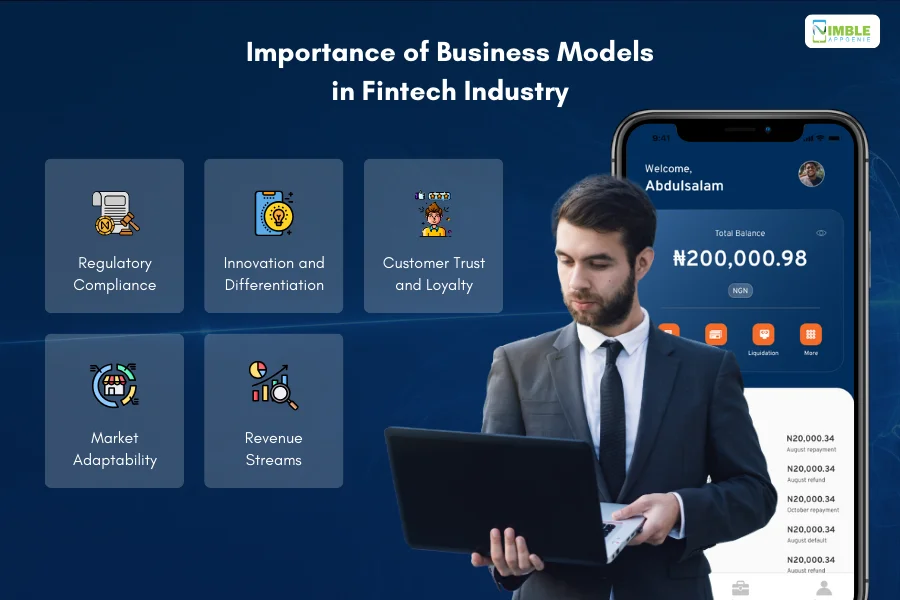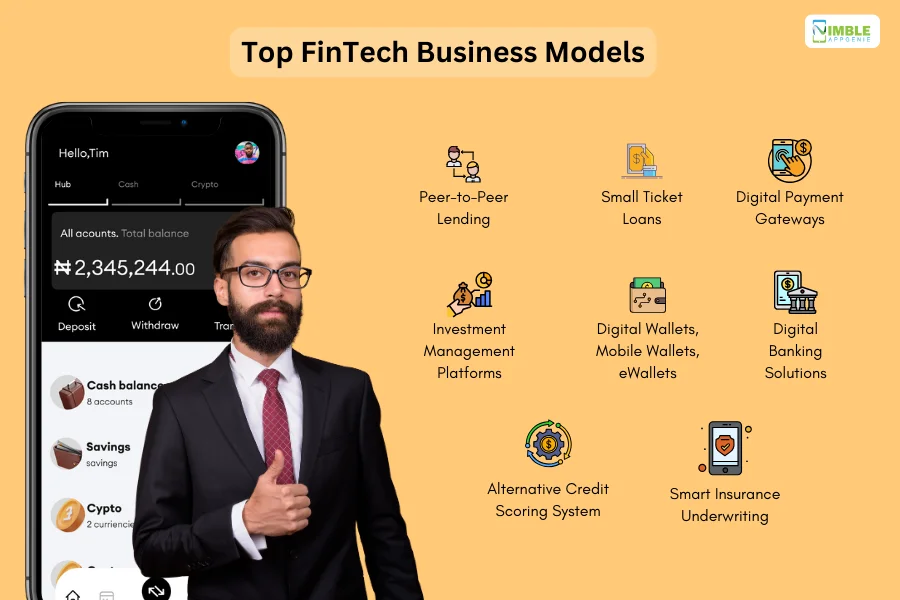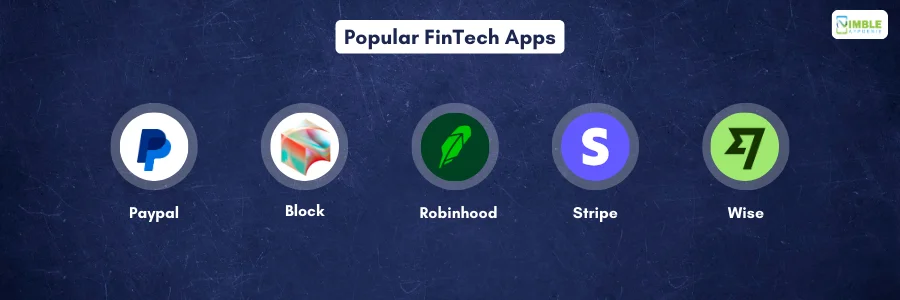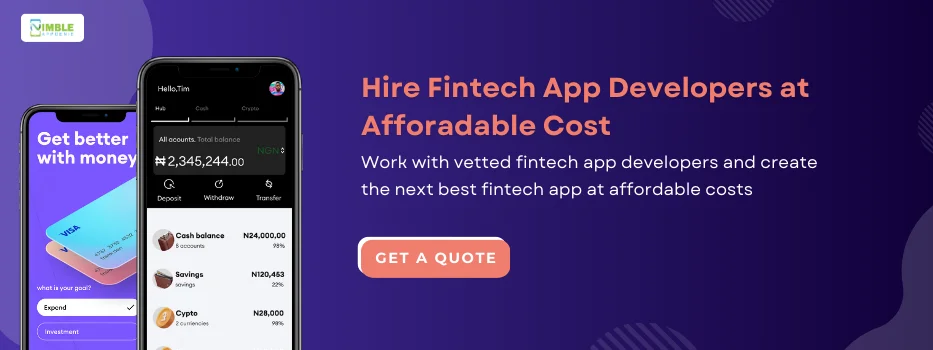Fintech is all the rage right now.
With various Fintech business models, many companies have developed market-leading solutions and generated billions in revenue.
Today, the Fintech industry is worth billions. This isn’t all surprising considering the fact that millions of people across the world use Fintech apps in their day-to-day activities.
Especially in the United States of America, Fintech solutions have grown very famous among users.
As one might guess, the growth in the Fintech industry and the exciting opportunity it offers has attracted a lot of attention from start-ups to be, businesses, and established companies.
There are a lot of people who want to start their own fintech business.
However, the problem is, that not everyone is all that familiar with the Fintech industry business model. They don’t know how things work in this market and how to create a solution. But don’t let this bother you, because we are here to help you.
This complete guide to fintech business models will discuss everything you need to know about Fintech business models and create your own Fintech app. For our less tech-savvy readers, we shall also discuss the basics.
Therefore, this being Let’s get right into it:
Growing Fintech Industry: An Overview
Fintech stands for financial technologies.
In recent years, this industry has completely taken over traditional financial work, changing everything to a much faster, safer, and easy-to-use digital alternative.
In fact, fintech apps don’t even need an introduction considering their popularity and widespread use. While there are billions who use fintech solutions in their day-to-day life, there are some who want to create a fintech app of their own.
In order to do this, it’s important to have a basic understanding of the concept as well as the market.
To achieve just that, in this section of the blog, we shall be going through the top fintech app statistics, these are, as mentioned below:
- The global Fintech market was valued at USD 133.84 billion in 2022 and is projected to reach USD 556.58 billion by 2030, with a CAGR of 19.50%.
- The number of Fintech startups in America was 10,755, EMEA(Europe, Middle East, and Africa) had 9,323, and Asia Pacific had 6,268.
- 78% of Americans use at least one digital banking product.
- Over 80 million people in Europe will use neobanks by 2025.
- 31% of the world population remains unbanked, presenting a potential market for inclusive Fintech solutions.
eWallet app statistics also show us amazing growth in online transactions and so do loan lending statistics.
But moving past that, now that you have a basic understanding of fintech, it’s time to what are fintech business models in the section below.
What is a FinTech Business Model?
So, what are fintech business models?
A fintech business model is a strategic blueprint that financial technology companies employ to deliver innovative financial services, streamline operations, and generate revenue in the digital age.
It is the foundation upon which fintech firms build their approach to disrupting traditional financial sectors, including banking, insurance, and investment management, by leveraging cutting-edge technologies.
At its core, a fintech business model is characterized by its use of software and mobile app development to create and deliver financial services that are more accessible, efficient, and user-friendly than those of traditional financial institutions.
But why is it important? Well, let’s answer just that in the section below.
Importance of Business Models in Fintech Industry
The financial industry on its own is huge, as we all know.

However, fintech is the future and it’s here to stay. So, if you are a financial business or institution adopting fintech business model is a must if you want to stay relevant to the market.
But that’s not all, there are a number of reasons why business models in the fintech industry are important.
Let’s discuss them in detail below.
1. Regulatory Compliance
The financial sector is heavily regulated worldwide and that’s no secret.
While you may not do it knowingly, not adhering to these compliances can often get your business in trouble with fines and a damaged reputation.
That’s why a fintech company’s business model is important.
A well-designed one helps ensure compliance with regulatory requirements like PCI and GDPR across different jurisdictions, mitigating legal risks and building trust with users.
2. Innovation and Differentiation
It is the dream of every fintech company to disrupt traditional financial services with innovative solutions. Isn’t it?
You can do just that, with top fintech business models
A well-defined business model helps in articulating the unique value proposition and differentiating the company from both traditional financial institutions and other fintech startups.
3. Customer Trust and Loyalty
Do you want to be successful in the user base, as THE fintech company?
Customer trust and loyalty are something every business strives to achieve. After all, trust is a cornerstone in financial services.
A fintech industry business model can certainly help with it, by prioritizing security, privacy, and customer-centric services to foster trust and loyalty.
This is critical for customer retention and acquisition in a competitive market.
4. Market Adaptability
With recent technological advancements, consumer behavior shifts, and regulatory changes, the financial industry is subject to rapid changes
You can surf this wave with a flexible business model that enables fintech companies to adapt quickly and capitalize on new opportunities.
5. Revenue Streams
Want to make money with fintech solutions?
A robust business model outlines clear monetization strategies, whether through transaction fees, subscription models, or premium services.
It helps you identify and diversify revenue streams that are crucial for the financial sustainability of a fintech company.
These are some of the reasons why financial business models are important for modern companies. Now, let’s see how business models differ from monetization models.
Fintech Business Model vs Fintech Monetization Models
It’s quite easy to confuse fintech business models with app monetization models due to both of them involving the “revenue” aspect.
That’s what leads to the business model vs monetization model debate. Let’s discuss just that in the section below.
| Aspect | Fintech Business Model | Monetization Model |
| Definition | Refers to the core structure and strategy a fintech company uses to deliver value to its customers and operate in the financial market. | Describes the specific methods and strategies a fintech company employs to generate revenue from its services. |
| Examples |
|
|
| Focus | on the type of service or product offered and how it’s delivered to the market. | on ways to extract financial value from the provided services or products. |
| Implementation | Involves developing technological platforms, complying with regulations, and establishing a market presence. | Involves pricing strategies, sales models, and financial partnerships to enhance revenue streams. |
| Customer Interaction | Dictated by the service model, e.g., how users interact with a digital banking app vs. an investment platform. | Influenced by the pricing model and perceived value, e.g., willingness to pay subscription fees for premium services. |
| Revenue Connection | Indirect; the business model sets the stage for potential revenue generation. | Direct: specifically outlines how the company makes money from its operations. |
| Adaptability | Business models may evolve as the company scales or as market demands shift. | Monetization models can be adjusted more frequently in response to user feedback or competitive pressures. |
| Value Proposition | Defined by the uniqueness of the fintech solution and its market fit. | Defined by the cost-benefit ratio to the customer, influencing the adoption rate. |
With all said and done, it’s time to look at the top fintech business models in the section below, let’s get started.
Top Fintech Business Models
There are as many fintech business models as there are niches in the industry. And in this section of the blog, we shall be going through the most prominent types of financial business models.

Therefore, with this being said, let’s get right into it:
► Alternative Credit Scoring System
So, what’s a credit scoring system?
A credit score is an important concept that helps financial institutions determine how risky it is to lend someone their services.
As such, people with lower credit scores have to pay higher fees and interest rates, whereas, on the other hand, people with higher Credit Score have to pay less and get loans much easier.
Now, building a credit score isn’t all that easy and a lot of people suffer because of it.
You see, the global alternative credit scoring market is expected to reach USD 7.8 billion by 2027, growing at a CAGR of 24.4%.
With an alternative credit score business model of fintech, users can check lender creditworthiness by using relatable, current, and easily available data. This is done by tracking their digital footprint.
Traditional credit scoring often excludes underbanked populations. Alternative data like social media activity, phone call patterns, and utility payments can lead to a 20% increase in loan approvals for these groups
That’s why, this is a top Fintech financial model that a lot of companies across the market use.
Plus, this is also highly beneficial. Not to mention it’s one of the leading ideas for fintech solutions that you can find today.
Some of the popular Alternative score apps are, as mentioned:
- Nova Credit
- Canopy
- Cortera
Who Should Choose This Fintech Business Model?
Startups and financial institutions aim to expand financial inclusion by providing credit to underserved markets, such as individuals without traditional credit histories.
Why Choose This Business Model?
Alternative credit scoring model leverages non-traditional data (like utility payments, social media activity, and mobile phone usage) to assess creditworthiness, enabling lenders to reach a broader customer base.
Pros:
- Expands access to credit for underserved segments.
- Reduces reliance on traditional credit scoring methods.
- Can lead to lower default rates through enhanced risk assessment.
Cons:
- Privacy concerns over the use of personal data.
- Regulatory challenges in certain jurisdictions.
- Potential for biased outcomes if not properly managed.
► Smart Insurance Underwriting
The market for insurTech solutions is huge.
There are just so many insurance companies who want to launch an insurance app. And we have just the fintech business model for the insurtech platform.
“Smart insurance underwriting”
It is revolutionizing the way insurance companies assess risk and price policies. As leverages technology, data, and analytics to create a more efficient, accurate, and customer-centric process. Here are some key aspects of smart insurance underwriting:
- Telematics data
- Public Records
- Alternative data
What makes this a great model is the huge market and innovation it offers.
The global InsurTech market is expected to reach USD 341.36 billion by 2026, growing at a CAGR of 16.3% And 73% of consumers are willing to share data for personalized insurance experiences.
Wearables and telematics data can personalize insurance premiums based on driving habits or health metrics.
You can take it to the next level with your own custom solution.
Who Should Choose This Fintech Business Model?
Insurance companies are looking to innovate and improve risk assessment through AI, machine learning, and big data analytics.
Why Choose This Business Model?
With this business model of financial technology, you can enable more accurate risk assessment, personalized insurance policies, and dynamic pricing based on real-time data, leading to higher efficiency and customer satisfaction.
Pros:
- Enhanced risk assessment accuracy.
- Personalized and flexible insurance offerings.
- Improved customer experience and satisfaction.
Cons:
- High initial technology investment.
- Data privacy and security concerns.
- Potential regulatory hurdles.
► Peer-to-Peer Lending
Here we have it, the popular P2P and Peer-to-Peer Lending.
The global P2P lending market is projected to reach USD 468.9 billion by 2025, with a CAGR of 25.5%. This makes it one of the most popular finance industry business models. After all, with the low cost to develop lending platforms, it has become people’s favorite business model.
For those who don’t know, P2P platforms offer loans to borrowers with thin credit files or those seeking lower interest rates compared to traditional banks. This often comes to life with the help of loan lending app development.
The platform is adorned with a range of amazing features, from flexible repayments to instant soft loans. With the benefits the platform offers, the market is filled with amazing loan lending apps.
In fact, the growth all over the world is amazing.
As of today, China dominates the P2P lending market with a 70% share, followed by the US and the UK (PwC).
This can be the perfect business model for fintech startups who are looking to establish a place for themselves in the market.
It’s the right time to add your business name to top loan lending apps.
Who Should Choose This Fintech Business Model?
Entrepreneurs are interested in creating platforms that connect borrowers directly with investors, bypassing traditional financial intermediaries.
Why Choose This Business Model?
This fintech business model offers an alternative financing solution for borrowers while providing investors with higher returns compared to traditional savings accounts.
Pros:
- Access to credit for those who might not qualify through traditional banks.
- Potentially higher returns for investors.
- More competitive interest rates for borrowers.
Cons:
- Credit risk for investors.
- Regulatory challenges and compliance.
- Dependency on the platform’s ability to match borrowers with investors.
► Small Ticket Loans
Another application of loan lending solution is small ticket loans.
As one of the innovative fintech business model, Microfinance platforms and BNPL solutions provide quick and affordable loans to underserved populations, promoting financial inclusion.
Nevertheless, as easily & readily available as it is, getting a loan isn’t all that simple. It requires several bank visits and tons of paperwork, and even then your application might not be approved as it is not profitable for the bank.
In fact, it is quite common for banks to say no just to “small-ticket” loans due to low margins and the relatively high cost of setting up and recovering those loans.
Nevertheless, where a bank doesn’t help, fintech companies come to save the day. In this model, you can offer them soft loans.
A very common example of this model is Buy Now Pay Later app like Afterpay. Another one is cash advance apps.
These loans can be availed through mobile applications and don’t require the days-long process to proceed.
Moreover, there is a 0% interest rate and the client has to pay the amount within a month or so. As far as revenue generation is concerned, it can be done through late fees and partnership commissions.
And not to mention, there’s huge demand: 2.1 billion adults globally lack access to formal financial services, creating a massive need for small loans.
Who Should Choose This Fintech Business Model?
Fintech startups focused on providing short-term, low-value loans to individuals or small businesses quickly and with minimal paperwork.
Why Choose This Business Model?
Meets the demand for immediate, short-term financing needs, especially in markets with a significant unbanked population.
Pros:
- Quick and convenient access to funds.
- Serves an underserved segment of the market.
- Potential for high volume and scalability.
Cons:
- High interest rates and fees can lead to debt traps for consumers.
- Regulatory scrutiny and the potential for increased regulation.
- Risk of high default rates.
► Investment Management Platforms
Investment has been growing popular among the common populous in recent years.
Studies show that as much as 56% of the U.S. population invest in stocks, and a large portion of these are active traders. Robo-advisors manage over USD 1 trillion in assets globally, and their assets are expected to reach USD 12.2 trillion by 2027
This gives us a clear picture of the investment landscape in the USA.
While there are a lot of people who are involved in it, the majority of them suffer from investment mismanagement. This doesn’t only mean a lot of loft opportunities but also huge losses at times.
And this is a problem you can bring a solution to.
Hire fintech developers and go for capital management solution development. Traders will be able to manage their investment operations regardless of their location through the mobile phone.
Some of the popular examples of such investment management apps are,
- Betterment
- eToro
- Robinhood
Apart from traditional wealth management, you can also integrate it with Blockchain technology.
The reason is that 13% of Americans invest use cryptocurrency trading apps. You can offer them a unique platform to track their investment.
This Fintech business model has high potential and there are already companies that have generated billions in the market through the same.
Who Should Choose This Fintech Business Model?
Startups and financial institutions aim to provide individuals and SMEs with digital tools for investment management, financial planning, and advisory services.
Why Choose This Business Model?
Democratizes access to asset management services, traditionally available only to high-net-worth individuals, by using technology to lower costs and minimum investment thresholds.
Pros:
- Broadens access to investment management services.
- Lower fees compared to traditional asset management.
- Customized investment strategies using AI and algorithms.
Cons:
- Market volatility and investment risks.
- Requires continuous technological innovation to stay competitive.
- Regulatory and compliance requirements.
► Digital Payment Gateways
With global mobile payment transaction volumes expected to reach USD 45.7 trillion by 2026, it’s right for this fintech app business model to mature.
Digital payment gateways, as the name suggests, enable users to send money and other users or vendors to accept it. This can be triggered via, eWallet apps, credit cards, debit cards, and so on.
Due to the recent adoption, digital payment statistics show us that Digital payment gateways are expanding rapidly in Africa and Asia, providing financial access to unbanked populations.
And to move towards are cashless societies Countries like Sweden and China are leading the shift towards cashless economies, driven by convenient and secure digital payments.
There are various ways this can be one of the prominent fintech business models. Covering both the needs of the users and accommodating merchant payment providers.
Moreover, you can see, that digital payment gateway comes in many forms and sizes. There are various people who create money transfer platforms based on the same.
Some examples of popular digital payment gateways are, as mentioned below:
- Paypal
- Stripe
- Clover
Now, who should go for this business model?
Who Should Choose This Fintech Business Model?
Entrepreneurs aim to facilitate online transactions for e-commerce businesses, offering secure and efficient payment processing solutions.
Why Choose This Business Model?
This fintech solution business model supports the growing demand for e-commerce by enabling seamless and secure online transactions, enhancing the user experience.
Pros:
- Facilitates the growth of e-commerce and online services.
- Offers secure and efficient transaction processing.
- Integrates various payment methods to cater to diverse customer preferences.
Cons:
- High competition from established players.
- Security risks associated with online transactions.
- Compliance with international payment standards and regulations.
► Digital Wallets, Mobile Wallets, eWallets
Why does everyone want to create an eWallet app?
Well, this is one of the best fintech business models today.
Over 3.5 billion people globally use mobile wallets, and their number is expected to reach 4.8 billion by 2025
We are living in the 21st century and you no longer need to carry a wallet. Not physically at least. Due to the advancement in fintech, all you need is a mobile phone.
Giving us, digital wallets, mobile wallets, and eWallets.
While there is no need to define digital payment apps, these store payment cards, loyalty programs, and IDs, simplifying everyday transactions.
You see, a lot of people carry bulky wallets filled with cash, cards, and other important documents with them, as there is no other option.
But with this app, you can replace a physical wallet with a digital one.
As the name suggests, eWallet applications are installed on our phones and they allow us to do virtually anything finance-related.
You can transfer money, pay for shopping in an instant, recharge your phone, transfer funds through the bank, check your bank balance, pay bills, open a new account, and so on.
eWallet app development can give you solutions as per your business needs and ideas. And with this app, you can lead the market.
There are many examples of successful eWallet applications that have helped their parent companies dominate the market while generating record-breaking revenue.
Therefore, this is a Fintech business model that you should definitely have a long at.
Who Should Choose This Fintech Business Model?
Companies looking to offer a convenient and secure digital alternative to traditional wallets, enabling users to store payment information and make transactions electronically.
Why Choose This Business Model?
As a popular business model in the finance industry, caters to the increasing consumer preference for digital payments, driven by convenience, speed, and added functionalities like rewards and budget tracking.
Pros:
- Enhanced convenience and user experience.
- Reduced need for physical wallets and cash.
- Opportunity for integration with loyalty programs and financial services.
Cons:
- Security vulnerabilities and fraud risks.
- Requires widespread merchant adoption to be effective.
- Regulatory compliance and data privacy concerns.
► Digital Banking Solutions
NeoBank App Development has become one of the top fintech business models.
Today, over 80 million people in Europe will use neobanks by 2025. As traditional banks struggle to compete with neobanks’ lower fees, user-friendly apps, and innovative features, they are partnering with FinTech companies to offer digital banking solutions.
There are various popular mobile banking apps in the market like Bank of America. But all of them focus on mainly one task, digitalization, and automation.
You see, only half a decade ago, you had to visit a bank branch for virtually every task. However, with the introduction of mobile banking app development, that became history.
As of today, more than 64% of Americans use at least one digital banking product. In Europe, Over 80 million people are expected to use mobile banking.
This clearly shows the popularity of the concept as well as its future potential. This is one of the best business models on the list and definitely worth your consideration.
Now, all you need to do is apply this business model to your platform. Or create a mobile banking solution of your own from the ground up.
Who Should Choose This Fintech Business Model?
Startups and traditional banks aim to offer banking services entirely online, including account management, transfers, loans, and more.
Why Choose This Business Model?
The digital banking business model meets the demand for convenient, 24/7 banking services, appealing to tech-savvy consumers and those seeking alternatives to traditional banking.
Pros:
- The convenience of accessing banking services anytime, anywhere.
- Lower operational costs compared to traditional banks.
- Quick and innovative financial product deployment.
Cons:
- The lack of physical branches may deter some customers.
- Security and privacy concerns with online banking.
- Regulatory hurdles and ensuring compliance with financial regulations.
And that’s that. These were different fintech business models in the market. Let’s move to the next section now.
Popular Fintech Apps and Their Business Models
The market is filled with top fintech apps.

More often than not, fintech businesses as well as start-ups are inspired by these platforms to go for their own.
So before you invest in a fintech app, here are some of the top platforms and their fintech business models.
Take a look at the below.
1. PayPal
Let’s start with the discussion with OG, PayPal.
The platform is so popular that the market is filled with apps like PayPal. Let’s look at it’s business models fintech startups so love.
PayPal Business Model
PayPal operates as a digital payment platform that allows users to make online payments and transfers.
The company generates revenue through transaction fees from merchants, international money transfers, and other financial services.
2. Square (Now Block)
Square is a platform that has inspired so many people to build an app like Cash. And now, it’s known as a block.
So, how does it make money and conduct its business? Let’s find out.
Block or Square Business Model
Square provides a range of financial services and tools for businesses, including payment processing, point-of-sale systems, and small-business financing.
The company earns money through transaction fees, subscription services for additional features, and interest on loans provided to businesses.
3. Robinhood
Want to create an investment platform? Well, let’s look at the fintech business model of the most popular investment platform, Robinhood.
Robinhood Business Model
Robinhood is an investment app that offers commission-free trades of stocks, ETFs, and cryptocurrencies.
Its revenue comes from three main sources: interest earned on customers’ cash balances, selling order information to high-frequency traders (payment for order flow), and its premium subscription service, Robinhood Gold.
4. Stripe
Stripe stands as an example of one of the most successful fintech business models. And for those who want to create a money transfer app.
Stripe Business Model
Stripe provides infrastructure for online payments, enabling businesses to accept payments over the Internet. The company’s revenue primarily comes from transaction fees, along with additional fees
5. Transfer Wise (now Wise)
For those inspired by cross-border money transfer apps, it’s time to look at the best in the market and its business model.
Wise Business Model
Wise is a financial technology company offering cheap, cross-border money transfers.
The company charges a transparent fee based on the amount transferred and the route, often undercutting traditional banks’ foreign exchange rates and transfer fees.
Now that we are done with the examples, in the next step of the fintech business model guide, we shall discuss how to choose the right one for you.
How To Choose the Right Fintech Business Model?
There are a lot of different fintech business models.
Truth be told, it can get a little confusing at times, juggling all these things and deciding which one to go for.
So, here’s a table of considerations to keep in mind when choosing a fintech business model.
| Dimensions | Consideration |
| 1. Customer Segment |
|
| 2. Value Proposition |
|
| 3. Revenue Model |
|
| 4. Technology Stack |
|
| 5. Regulatory Compliance |
|
| 6. Partnerships |
|
| 7. Cost Structure |
|
| 8. Market Trends |
|
| 9. Competition |
|
| 10. Scalability |
|
Nimble AppGenie, A Fintech Development Company, Turning Ideas To Digital Products
Have you found the perfect fintech business model for your venture or still confused? In any case, we are here to help you.
Nimble AppGenie is a renowned fintech app development company with years’ worth of experience in the market, working on 700+ projects, and delivering 95% client satisfaction.
Some of our top solutions are, as mentioned below:
- Pay By Check – Pay by Check is a popular ewallet mobile app in the United States of America. It allows users to transfer, pay, or even exchange currency.
- SatPay – An eWallet platform, it’s a Versatile eWallet Solution that allows users to request, receive, and send payment without hassle.
- CUT – an E-wallet Mobile App, CUT is available in China and Myanmar. It works well with both RMB and MMK currencies.
- SatBorsa – a Currency Exchange Fintech app, SatBorsa is one of the platforms that is available on both platforms, iOS, and Android.
For our contribution to the fintech industry, we are recognized by top platforms like Clutch.com, GoodFirms, and DesignRush. It’s the right time to turn the idea into reality backed by a robust fintech business model.
Hire mobile app developers in 2024 hours, we are just a click away.
Conclusion
Fintech or financial technology is one of the largest and clearly most profitable industries in the world. Various Fintech companies have developed their own Fintech apps, following specific Fintech business models to generate billions of dollars in the market.
Now, if this has inspired you to start your own business with one of the fintech business models and create a market-leading fintech application, you should consult a stellar app development company that will take you to the next level.
FAQs
A fintech business model is the strategic framework that financial technology companies use to deliver innovative financial services, streamline operations, and generate revenue by leveraging advanced technologies. This includes the use of software and mobile apps to offer services that are more accessible and user-friendly than traditional financial institutions.
Business models in the fintech industry are crucial because they ensure regulatory compliance, foster innovation and differentiation, build customer trust and loyalty, enable market adaptability, and define clear revenue streams. These elements are vital for staying relevant and competitive in the rapidly evolving financial market.
Fintech business models outline the core structure and strategy for delivering value and operating in the financial market, focusing on the type of service or product offered. In contrast, monetization models describe specific methods to generate revenue from these services or products, focusing on financial value extraction.
A fintech business plan outlines the strategic approach a fintech startup or company will take to address a specific problem within the financial industry using technology. Key components of a fintech business plan include:
- Executive Summary
- Market Analysis
- Company Description
- Organization and Management
- Services or Products Offered
- Marketing Plan
- Operational Plan
- Financial Plan
Prominent fintech business models include Alternative Credit Scoring Systems, Smart Insurance Underwriting, Peer-to-Peer Lending, Small Ticket Loans, Investment Management Platforms, Digital Payment Gateways, Digital Wallets (eWallets), and Digital Banking Solutions. Each model caters to different market needs and leverages technology to enhance financial services.
Choosing the right fintech business model involves considering factors such as the target customer segment, value proposition, revenue model, technology stack, regulatory compliance, partnerships, cost structure, market trends, competition, and scalability. Understanding these dimensions helps in selecting a model that aligns with market needs and business objectives.
The fintech industry is known for its innovative and disruptive business models that have significantly transformed traditional financial services. Some of the most interesting fintech business models include:
- Blockchain and Cryptocurrency Platforms
- Neobanks and Challenger Banks
- InsurTech
- RegTech
- Robo-Advisors
- Buy Now, Pay Later (BNPL)

Udai Singh is a senior content writer with over 6 years of experience in creating content for FinTech, eWallet, EdTech, and App Development. He is an expert in simplifying complex concepts and creating engaging content that resonates with the audience.
Table of Contents













No Comments
Comments are closed.